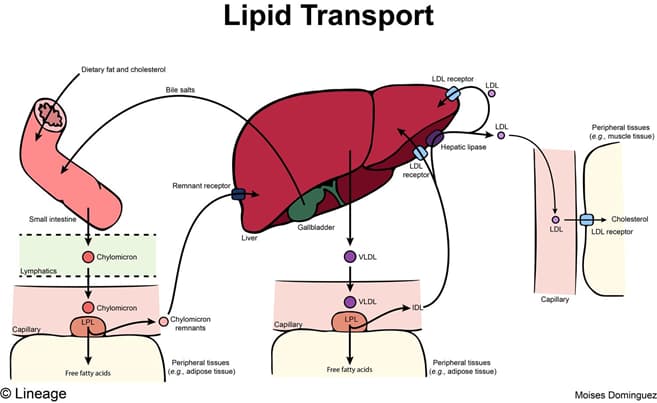Overview – Apolipoproteins

- A 50-year-old woman presents to her primary care physician for a regular checkup. She states that for the past four months she has not experienced menses. Her primary care physician suspects that she has gone through menopause. On routine lab work, her LDL has increased as compared to one year ago, and her HDL has decreased drastically.
Introduction
- Mechanisms for fatty acid and cholesterol transport
- Different types that vary by
- density
- most dense
- HDL (high density)
- LDL (low density)
- IDL (intermediate density)
- VLDL (very low density)
- chylomicrons
- least dense
- most dense
- types of apolipoprotein
- density
HDL
- Function
- transfer cholesterol
- tissues → liver
- good cholesterol
- transfer cholesterol
- Structure
- apolipoproteins donated to chylomicrons and VLDL
LDL
- Function
- transfer cholesterol
- liver → tissues
- most recycles back to be absorbed by the liver
- liver → tissues
- bad cholesterol
- transfer cholesterol
- Structure
- mediates endocytosis of LDL by binding to apoB-100 (LDL) receptor on liver and tissues
IDL
- Function
- VLDL → IDL + TGs
- picks up cholesterol esters from HDL
- catalyzed by cholesterol ester transfer protein (CETP)
- IDL + cholesterol from HDL → LDL
- Structure
- apoE
- recieves from HDL
- mediates uptake by the liver
- remember: apoE empties to liver
- apoB-100
- apoE
- mediates endocytosis of LDL by binding to apoB-100 (LDL) receptor on liver and tissues
VLDL
- Function
- transports TGs
- liver → tissues
- transports TGs
- Structure
- apoB-100
- form packaged and secreted from liver
- apoC-II
- activates lipoprotein lipase
- catalyzes hydrolysis of triglycerides into individual FAs for absorbtion
- ↑ regulated by insulin
- activates lipoprotein lipase
- apoE
- apoB-100
- mediates uptake by the liver
Chylomicrons
- Function
- transport cholesterol, TGs, FAs, and fat soluble vitamins
- intestine → tissues
- released from intestinal lumen cells into lymphatics
- transport cholesterol, TGs, FAs, and fat soluble vitamins
- Structure
- apo-48
- form packaged and secreted by intestine
- apoC-II
- activates lipoprotein lipase
- added from HDL
- apoE
- mediates uptake by the liver
- added from HDL
- apo-48
Apolipoproteins Functions
Apolipoproteins have several important functions in the body, including:
- Transport of lipids: Apolipoproteins bind to lipids (such as cholesterol and triglycerides) to form lipoproteins, which transport these molecules through the bloodstream to various tissues and organs.
- Structural support: Apolipoproteins provide structural support to lipoproteins, helping them maintain their shape and stability.
- Enzyme activation: Some apolipoproteins (such as ApoC-II) activate enzymes that break down lipids, allowing them to be used for energy production.
- Immune function: Apolipoproteins are involved in the immune response, including the transport of immune cells and molecules to sites of infection or inflammation.
- Hormone regulation: Lipoproteins that contain certain apolipoproteins (such as ApoE) can interact with hormones and signaling molecules, affecting their function and distribution in the body.
Overall, apolipoproteins play a critical role in lipid metabolism and are essential for the proper functioning of many physiological processes in the body.
Types
There are several types of apolipoproteins that are classified based on their structure, function, and the type of lipoprotein they are associated with. Some of the main types of apolipoproteins include:
- Apolipoprotein A (ApoA): ApoA is the primary apolipoprotein found in high-density lipoprotein (HDL), also known as the “good” cholesterol. It plays a critical role in reverse cholesterol transport, the process by which excess cholesterol is removed from the body.
- Apolipoprotein B (ApoB): ApoB is the primary apolipoprotein found in low-density lipoprotein (LDL), also known as the “bad” cholesterol. It is responsible for carrying cholesterol and other lipids to tissues throughout the body, and high levels of ApoB are associated with an increased risk of cardiovascular disease.
- Apolipoprotein C (ApoC): There are several types of ApoC proteins, including ApoC-I, ApoC-II, ApoC-III, and ApoC-IV. They are mainly associated with very low-density lipoprotein (VLDL) and intermediate-density lipoprotein (IDL), and are involved in the breakdown of triglycerides.
- Apolipoprotein E (ApoE): ApoE is found in several types of lipoproteins, including VLDL, LDL, and HDL. It plays a role in the clearance of lipoproteins from the bloodstream and is associated with an increased risk of cardiovascular disease when certain genetic variants are present.
- Apolipoprotein L (ApoL): ApoL is found in HDL and is involved in the transport of lipids and other molecules.
Overall, these different types of apolipoproteins play a critical role in lipid metabolism and are associated with various health outcomes.
Studies
There have been numerous studies on apolipoproteins and their role in health and disease. Some of the key findings include:
- Apolipoproteins are better predictors of cardiovascular disease (CVD) risk than traditional lipid measures such as total cholesterol, LDL, and HDL cholesterol. This is because they reflect the functional state of lipoproteins, rather than just their concentration.
- High levels of ApoB and low levels of ApoA are associated with increased risk of CVD.
- Certain genetic variations in apolipoproteins can increase or decrease the risk of developing CVD. For example, a variant of the ApoE gene called ApoE4 is associated with increased risk of Alzheimer’s disease and CVD.
- Apolipoproteins may play a role in other diseases, such as diabetes, obesity, and liver disease.
- Lifestyle interventions, such as diet and exercise, can improve apolipoprotein levels and reduce CVD risk.
Overall, studying apolipoproteins provides important insights into the mechanisms underlying lipid metabolism and CVD, and may lead to new diagnostic and therapeutic approaches for these conditions.
Check out USMLE Success Strategy: Personalized Consultation and Study Plan Development.


